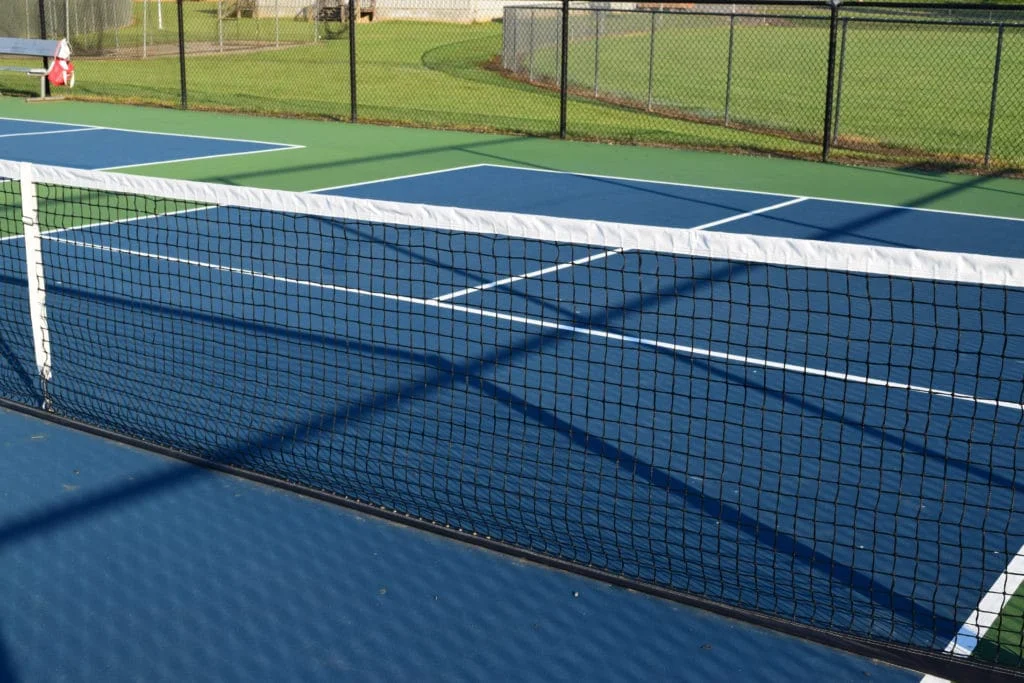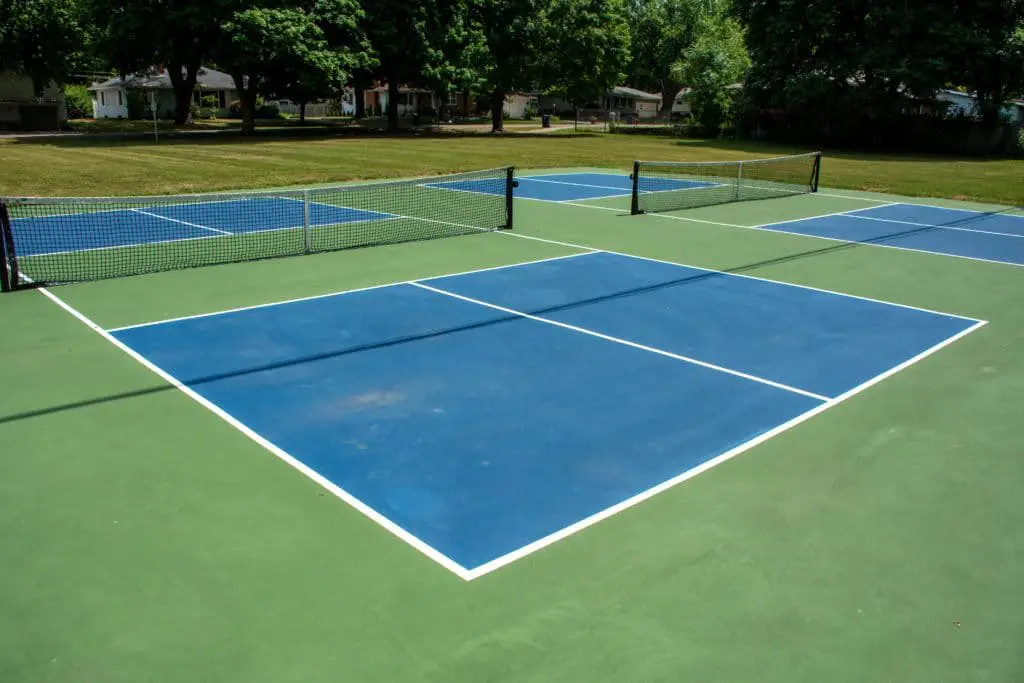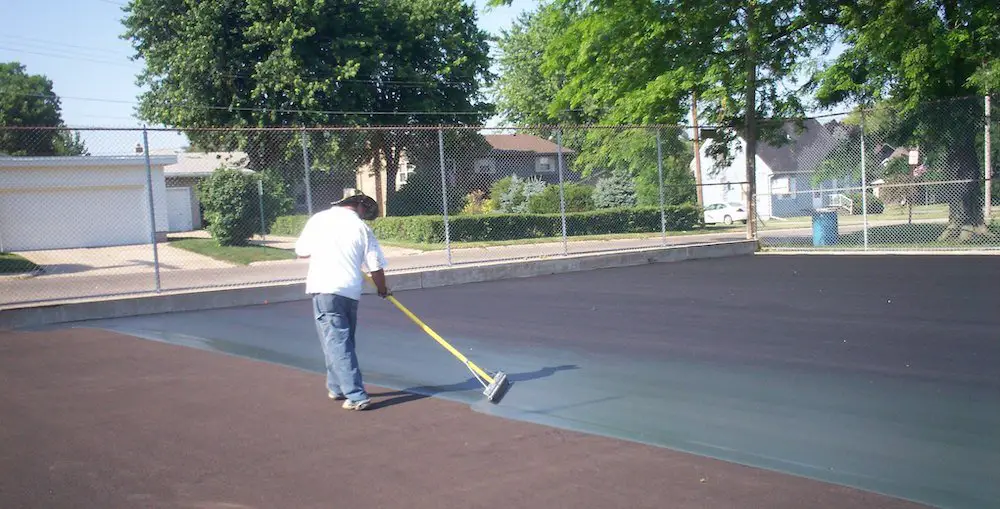There are a few ways to go about setting up and building a pickleball court. There’s the hard way (detailed below) where you are actually building an outdoor pickleball court from scratch. The medium-hard way – setting one up indoors, using an indoor basketball or tennis court.
Or the easy way, where you are using an existing outdoor court or other surface and setting up temporary nets and lines in order to play. If you want the easy way, head over to this article where we cover how to set up and play pickleball on a tennis court and then check out our buying guide for portable pickleball nets and our article on what equipment you need to play.
If you want to do it the hard way: first read this article and then buy this book (affiliate link):
People typically contract court surface specialists to assist with the job. There are a number of steps to the process, from starting the construction to finishing painting the court’s lines.

In this guide, we will go over at a high level the steps needed to understand how pickleball courts are made from start to finish. Some options you can do yourself, some might require a specialist to come in, but at least you’ll have the understanding and tools to be smart about it!
So let’s go – the hard way to build a pickleball court…
Looking to improve your game?
Check out this excellent pickleball video training course from High Performance Pickleball Academy. (Affiliate link) They break down the game into 8 key skills and instruct you on how to master them.
Dimensions of a Pickleball Court
The very first thing a contractor will need to do is have a meeting with you, to discuss the size of a pickleball court you’d like to have. This step will depend on the amount of space available, as well as your preferences.
If you’re looking for a USAPA-approved pickleball court, you’re going to need to have a lot of open space. The dimensions of a pickleball court as laid out by USAPA include:
- 20 feet wide (inclusive of lines)
- 44 feet deep (inclusive of lines)
- 48.4 feet diagonal (from corner to corner)
Now that’s just the actual court (contained within the lines). In order to provide enough room outside the lines to play (for serves and chasing down balls), you’ll need an area that’s at least 30 feet wide, 60 feet but the USAPA recommends that you leave room for 34 feet by 64 feet.
However, if you’re making a court for casual play, you can adjust the dimensions of a pickleball court. The court surface specialists you choose will help to make the process incredibly easy along the way and give you their professional advice, as well.
Related post: Can you play pickleball on grass?
How to Build a Pickleball Court
Once you have decided on the size of a pickleball court that you’d like on your property, you’ll then move onto the next step of the planning process, which is selecting materials.

Step 1: Identify the location and space for the build
If you’re building a single court, you won’t need as much space as a tennis or basketball court, but if you’re building for multiple courts, you’ll need a similar size space.
As mentioned above, the actual lines of a pickleball court are 20 feet by 44 feet, but you need extra room outside of that to account for the net posts and room to play the ball outside of the lines and for volleys.
For a single court, you should leave at a space of at least 30 by 60 feet, but if you can pad each side with a few more feet that will give you sufficient room for volleys and running after shots.
For 4 courts, you need roughly the same amount of space as a tennis court surface provides. You should be good with a minimum surface of 60 feet wide, 120 feet long.
One key thing to remember: orient the court so that it’s north-south, not east-west. This is standard practice on tennis courts as well in order to limit the sun getting in your eyes as much as possible.
Make sure there are no legal issues with setting up your court such as neighborhood rules or local/state regulations. We are not lawyers so don’t rely on us on this part, but make sure you’ve covered this base before getting going.
Also make sure this won’t disturb your neighbors since noise is an issue with pickleball.
Step 2: Decide on and prepare the Materials Needed
Wondering how much it costs to build a pickleball court? The first thing to think about is materials since that will be the biggest driver of the cost of setting this pickleball court up. The more money it takes to source the products for your court, the more expensive it’s likely to be. And the court surfacing will be the bulk of the cost.
Most court surface companies will have a set array of materials that they like to work with for longevity, durability, and comfort while playing.
It’s not a surprise that most pickleball courts are made from the same materials as basketball and tennis courts, which includes concrete, asphalt, and snap-together tiles. There can also be other products added to the court to make it a better playable surface, such as padding.
- Concrete
Concrete is one of the most popular pickleball court materials because of its affordability and durability. All the contractors will have to do is lay the surface in the desired area and grade it for proper drainage. After this is complete, they can finish the surface with your chosen paint and lines.
- Asphalt
Asphalt is another affordable and convenient solution for your pickleball court; however, it also comes with a little bit of extra upkeep. Depending on the quality of the land, a layer of concrete will be put down, and then it will be sprayed on top.
- Plastic Tiles
Whether you’re building a new court or want to restore an existing one, plastic tiles are a fantastic option. They are also more expensive than the latter two materials but can help you to avoid permanently altering an existing court.
For example, if you own a tennis court that needs pickleball lines, you can opt to have the plastic tiles installed on top. They are slightly better in terms of grip and impact on joints since it adds some cushion under your feet. That said it will run you $6,000 or $7,000.
- Other Materials
As earlier mentioned, there are different materials you can add to create a more comfortable playing experience, especially when it comes to padding.
Padding is essential, as it helps to absorb shock when playing sports. You’ll also love how it encourages your pickleball to pop when they hit the ground.
Step 2: Pick the Colors
This step is, by far, one of the most exciting parts of building a pickleball court, as you can create a design that captures your personality and works well with the aesthetic of your home.
There are numerous colors to choose from in terms of pickleball courts, allowing you to have full customization. Homeowners can also consider adding stencils or other exceptional graphics to make their courts unique.
You’ll want to choose a base color for the perimeter of the courts, a color to be placed in the playing space, as well as a color for the pickleball lines.
Step 3: Pick a Net System
Once everything to do with your pickleball court surface has been decided on, it’s time to consider the net system. There are plenty of different products to choose from, but each serves the purpose of giving you a professional playing space.
Since you’ve gone to the trouble of building a court, you’ll probably want to spring for permanent nets, but you can always go with a portable net system as well which will do the trick. The problem with the portable net systems is that they aren’t really meant to remain outside indefinitely so you would need to set them up and take them down ad needed.
Similar to tennis nets, the system you select transforms your court from a basic slab of material to a playable surface.
Most net systems feature materials that can stay outdoors during most seasons with little upkeep. However, you will want to make sure you can take the nets down during the off-season to preserve their integrity. The most important thing to ensure is durable is the pickleball post set.
As you won’t be removing the posts at the end of the season, because they are set in the concrete or asphalt, they should to be highly weather resistant.
Step 4: Choose Fencing and Lighting
This step is more of an important thing to consider if you intend to build multiple pickleball courts in the same area. You may want to think about fencing if you want the court placed somewhere that you won’t be able to control the flight path of the balls. With fencing, you can keep your courts secure, prevent others from playing on the court after hours, and allow for safe spectating.
When choosing a fence for a pickleball court, you’ll surely want to consider the size of a pickleball court. It will need to match the perimeter of your court and be anywhere from four to 10 feet high.
In terms of lighting, this can be a very convenient feature to have, especially if you love night games during the summer. Light is relatively standard and gives you the ability to make the most out of your court, so you always have optimal visibility.
Standard pickleball court dimensions should have at least two light poles that are 1,500 watts each, and they shall be near the center of the court.
Step 5: (Optional) Set up lighting for night play
Obviously this is only for you if you want to play after dark. This area is a bit outside of the scope of our expertise, so to learn more about this, these articles should help you get your bearings in relation to installing lighting on the court:
- https://www.tennisgems.com/cost-to-install-tennis-court-lights/
- https://www.accessfixtures.com/tennis-court-lights/
- https://www.ledspot.com/ls-commercial-lighting-info/sports-athletic-lighting/tennis-court-lighting/lighting-for-tennis-courts/
Regardless, adding lighting to your pickleball court will jump the price up significantly.
Related post: Pickleball Court Colors
How much does it cost to build a Pickleball court?
Really depends on the type of court you’re working with:
Cheapest option: Using an existing surface with portable net and court tape should be around $300.
Most expensive option for a single court: up to $40,000
The Costs of a Pickleball Court Surface
One of the main reasons as to why you might not already be a pickleball court owner is because of the cost to build a pickleball court. It can be a relatively expensive venture, especially if you’re installing a brand new court instead of resurfacing an existing one.
The right court surface specialists will be able to provide you with a custom quote depending on what you need, as every client is different.
It is essential to take note of the factors that could influence the cost of your court. These factors could include the natural grade of your land, accessibility to where the court will be, and the number of materials needed to do the job. On average, a new court can cost anywhere from $15,000 to $40,000, and below are some general figures you can consider.
Paint
You can bet there will need to be a lot of colors used for your project, especially if you’re going for a USAPA-approved court. The figures for paint vary a lot as well, as certain types are far more expensive than others.
A couple of examples include:
- Line Paint: $36.99/gallon
- Ready-Mix Color: $70.00 per 375 square feet
- Color Concentrate: $770 per 9,900 square feet
- Neutral Concentrate: $585 per 9,900 square feet
It is important to note that some colors are more expensive than others as they take longer to make and have substantially more pigment. For example, red court paint is more costly than green.
Lines are painted on at 2 inches wide.
Nets, Posts, and Sleeves
When installing your pickleball nets, you will typically need a net, posts, and sleeves. These come with their costs, including:
- Nets: $150 to $195
- Posts and Sleeves: $61 to $385
- Portable Net Systems: $50 to $545
Court Materials
The last item we’ll discuss in terms of the cost to build a pickleball court is how much it is to have the base materials placed on your property. Apart from the value of the materials, labor will drastically impact the price of this process. You will want to think about if the work needs to be outsourced.
I’m not terribly handy, so I would personally recommend consulting with contractor to help with the actual installation of the court surface. There are a whole host of considerations like drainage, moisture, digging out the space, ensuring level, etc! Too much for me.
- Concrete
Laying concrete varies from company to company; however, you can expect to pay anywhere from four to eight dollars per square foot.
- Asphalt
You’ll be glad to know that laying asphalt is relatively inexpensive, even when compared to concrete. Homeowners typically spend anywhere from three to four dollars per square foot for asphalt to be put on their property.
And again, if you don’t want through all that hassle, get a portable net and set it up wherever there’s a patch of concrete!



Thanks for mentioning choosing colors for a pickleball court that can be customized. I’m wanting to install a pickleball court in our backyard so we can all play as a family since we love it now. I’ll be sure to find some aesthetically pleasing colors to install for our court.